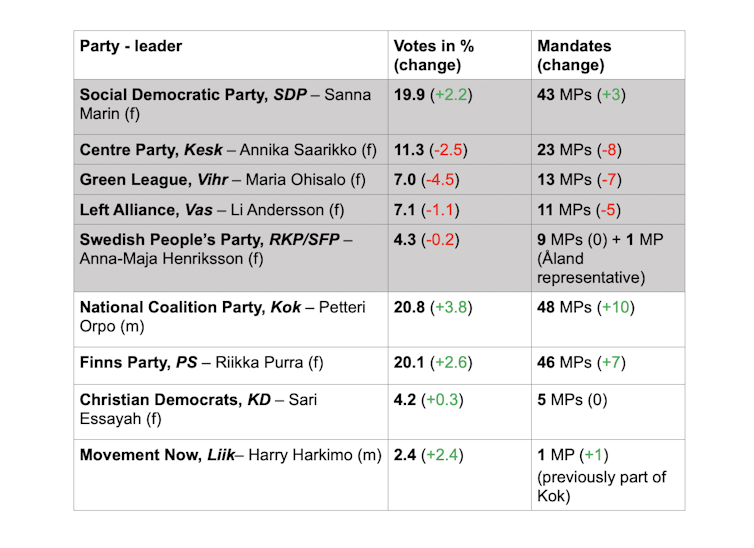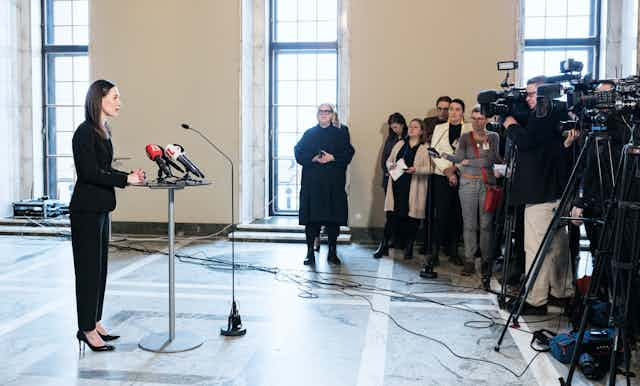The results of Finland’s parliamentary elections signal a tumultuous period ahead. This was to a certain degree foreseen by pre-election polls, which indicated that prime minister Sanna Marin’s Social Democratic Party (SDP) was about to lose to the opposition conservative National Coalition Party (Kok), led by Petteri Orpo.
The final election result showed a significant shift to the right – and increased success for rightwing populists in particular. The next government is therefore likely to be a coalition of rightwing parties but difficult negotiations lie ahead.
Marin received a very high number of personal votes and her party actually increased its vote share and parliamentary seats but it was not enough to make up for the significant losses suffered by her coalition partners.
Among these parties, only the social-liberal Swedish People’s Party of Finland (RKP/SFP) maintained its position. The Left Alliance (Vas) and the Green League (Vihr) both lost ground. There are indications that among the supporters of these parties some chose to vote tactically for SDP in an unsuccessful attempt to preserve Marin’s hold on the premiership.
Meanwhile, the most significant loses were suffered by the agrarian-liberal Centre Party (Kesk), which has now lost its status as one of Finland’s largest three political parties.
Kesk appears to have been replaced by the rightwing populist Finns Party (PS) on its home turf (namely, the northernmost regions of the country, such as the electoral districts of Lapland, Oulu, and Savonia-Karelia).
The PS has gained seven seats and now has 46 MPs, making it the second largest party in the new parliament. This indicates a heavy rightward shift among voters in both middle-sized cities and rural communities, as well as in the more ethnically homogeneous Finnish regions of the north, where the PS became the largest party. The PS has a new female leader, Riikka Purra, who seems keen to push even further on the radical agenda set by her predecessor Jussi Halla-aho. Purra proved to have significant personal popularity in this election.
The remaining seats are divided among the conservative Christian Democrats (KD) (5 MPs), the economically liberal one-man show Movement Now (Liike Nyt) (1 MP), and the representative of the autonomous Åland islands (1 MP, usually joining the parliamentary group of RKP/SFP on grounds of their common Swedish language).

Not all bad news for women in politics
While Finland has lost Marin as prime minister, from a gender perspective, the results of these elections nevertheless cement the standing of several women party leaders. Marin and Purra are the most prominent but seven out of the nine parties in parliament are now led by women. Even among the future MPs, the gender distribution is decently balanced, with 46% women and 54% men.
Marin was a trailblazer on the international stage as a young and charismatic woman heading the Finnish government and she did secure a very good result for her party. But this was not enough to shore up her coalition.
Marin showed clear leadership skills during the COVID-19 pandemic and the unfolding economic recession brought about by the war in Ukraine. However, it appears that the policies Marin and the SDP had identified to balance stimulating economic growth and public spending in education, social services, with preparation for a green transition did not gain enough traction among the Finnish electorate to guarantee her continued premiership.
Coalition talks ahead
Kok and Orpo’s winning ticket appears to have come off the back of promises to bring in financial restraint while expanding nuclear energy. The PS and Purra, meanwhile, ran on a platform literally promising to “Save Finland!” from alleged uncontrolled migration, EU meddling and the Finnish government’s welfare overspending.
As the leader of largest party in the coming parliament, Orpo now has the task of negotiating a stable governing coalition. Preferably, he will collect the support of more than half of the Finland’s 200 MPs to ensure that stability. The negotiations ahead won’t be easy, since any potential coalition with the rightwing populist PS makes for a very hard sell to the centre-right parties.
So even with the election over, it remains to be seen if Finnish politics is about to switch from being a source of international inspiration to being run according to a rightwing populist isolationist ideology.

